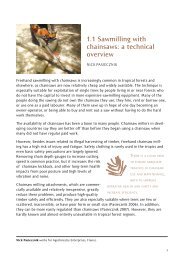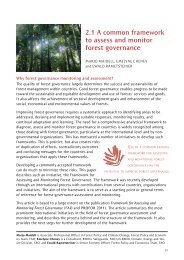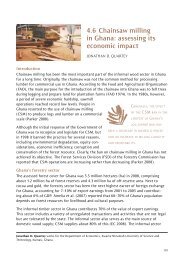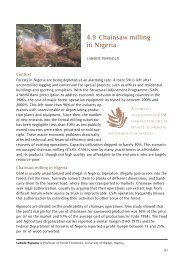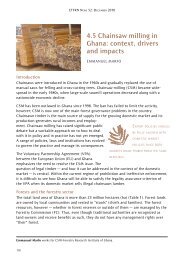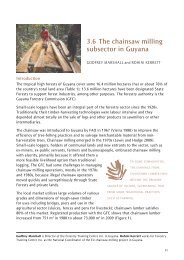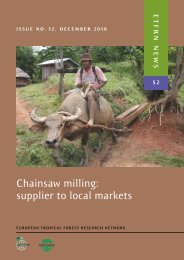Chainsaw milling: supplier to local markets - European Tropical ...
Chainsaw milling: supplier to local markets - European Tropical ...
Chainsaw milling: supplier to local markets - European Tropical ...
You also want an ePaper? Increase the reach of your titles
YUMPU automatically turns print PDFs into web optimized ePapers that Google loves.
198<br />
ETFRN NEws 52: DEcEmbER 2010<br />
private forests due <strong>to</strong> corruption and a shortage of staff. Consequently, freehand chainsawn<br />
timber does find its way <strong>to</strong> the formal market; it is easy <strong>to</strong> identify due <strong>to</strong> the<br />
distinctive marks made by chainsaws.<br />
The key players in timber <strong>markets</strong> are the <strong>supplier</strong>s of trees, primary processors, secondary<br />
processors and consumers (kazoora and Carvalho 2005). The timber producers are also<br />
involved in trading and so control the timber production and marketing chain (auren and<br />
krassowska 2004; uFsCs 2001).<br />
most of the timber produced is used by the building and construction sec<strong>to</strong>rs. board<br />
length is predominantly 4.2 m, a major cause of inefficiency in timber production (mwlE<br />
2001). Timber is marketed on the basis of species, size and quality, although the grading<br />
system is not fully entrenched. Due <strong>to</strong> the poor awareness<br />
of quality, there is little incentive for quality control.<br />
Evolution of production methods<br />
Commercial timber exploitation in uganda can be traced<br />
back <strong>to</strong> the introduction of pit-sawing at the beginning of<br />
the 20th century (odokonyero 2005a). pit-sawing remained<br />
the predominant method of timber production until the<br />
1930s, it was discouraged and saw<strong>milling</strong> commenced.<br />
The high demand for timber during world war ii attracted<br />
many firms <strong>to</strong> the forest industry, most with little if any<br />
knowledge of saw<strong>milling</strong>. They used very inefficient <strong>local</strong>ly<br />
made or second-hand machinery and had no interest in maintaining stable conditions or<br />
high standards. after the war, a number of these firms continued operating and continued<br />
<strong>to</strong> sell timber in a non-sustainable way with low timber prices for many years (Tack 1962).<br />
in the mid-1960s, the ministry of agriculture introduced the chainsaw in uganda <strong>to</strong><br />
facilitate pruning of coffee trees and bush clearing for planting coffee seedlings. The<br />
first chainsaws were small models with short bars and were mainly used for felling and<br />
cross-cutting small trees. Following the nationalization of sawmill industries in the 1970s,<br />
skilled workers dispersed. The industry deteriorated due <strong>to</strong> a lack of maintenance, spare<br />
parts and trained personnel (Carvalho and pickles 1994). most sawmills shut down and<br />
the few that remained were in a very poor condition (windhorst 2005; Carvalho and<br />
pickles 1994). Timber harvesting for export increased, creating a gap in the <strong>local</strong> timber<br />
market.<br />
in the mid-1970s chainsaws and pit-saws were widely used by encroachers in Central<br />
Forest reserves (CFrs). since pit-sawing was considered a slow process, more and larger<br />
models of chainsaws with long bars were imported and used.



